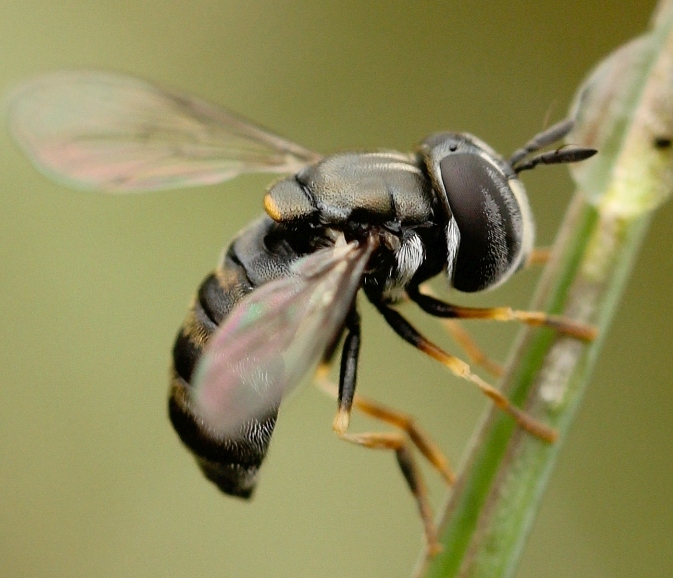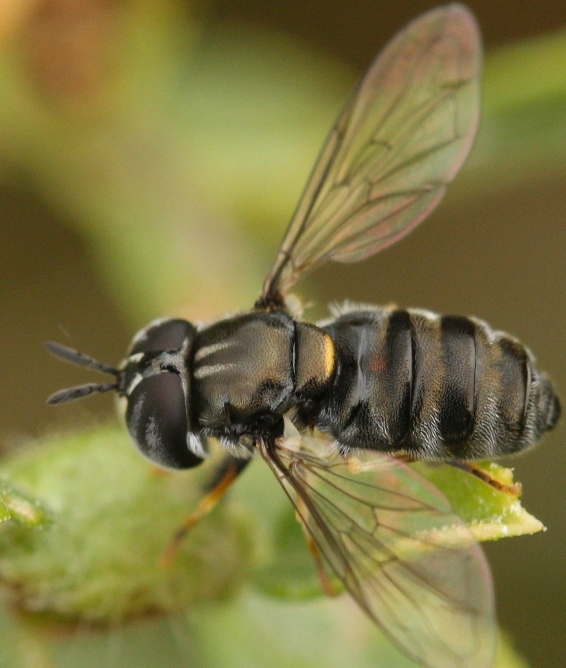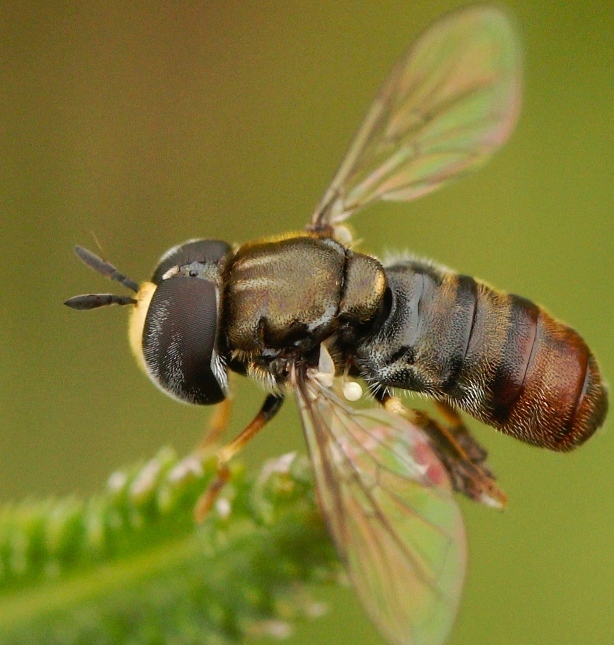Diptera.info :: Family forums :: Syrphidae
|
Paragus from Hungary
|
|
| piros |
Posted on 14-08-2017 18:23
|
|
Member Location: Szeged, Hungary Posts: 1817 Joined: 04.01.12 |
I found these flies, yesterday, near Bácsborista (Kelebia), about 35km W of Szeged. I believe that male and female belong to the same sp. In Hungary, 9 species of Paragus are known to occure: Paragus albifrons Paragus bicolor Paragus cinctus Paragus finitimus Paragus haemorrhous Paragus majoranae Paragus medeae Paragus punctulatus Paragus quadrifasciatus I think I could eliminate most these with the exception of P. medeae and P. cinctus. I found the description of P. medeae (based on males only), and it doesn't seem to fit. So I assume that this sp. could be Paragus cinctus, but I was unable to find anything about that sp. Could someone ID this flies? (I post picks of a female first.) Thanks for any help in advance! Greetings, Henrik piros attached the following image:  [193.69Kb] |
|
|
|
| piros |
Posted on 14-08-2017 18:23
|
|
Member Location: Szeged, Hungary Posts: 1817 Joined: 04.01.12 |
2.
piros attached the following image:  [193.85Kb] |
|
|
|
| piros |
Posted on 14-08-2017 18:24
|
|
Member Location: Szeged, Hungary Posts: 1817 Joined: 04.01.12 |
Male:
piros attached the following image:  [188.66Kb] |
|
|
|
| piros |
Posted on 14-08-2017 18:24
|
|
Member Location: Szeged, Hungary Posts: 1817 Joined: 04.01.12 |
2.
piros attached the following image:  [199.11Kb] Edited by piros on 14-08-2017 18:27 |
|
|
|
| piros |
Posted on 14-08-2017 18:33
|
|
Member Location: Szeged, Hungary Posts: 1817 Joined: 04.01.12 |
(To me, the presence of a depression at the anterior 1/3 of T2-4, covered by relatively long, semierect, yellowish hairs seems to be the most characteristic for these Paragus.) |
|
|
|
| Mihailo Vujic |
Posted on 14-08-2017 20:50
|
|
Member Location: Vrčin, Belgrade, Serbia Posts: 1072 Joined: 16.11.14 |
Hi Henrik, this is Paragus (subgenus Paragus) bicolor group species. In Europe are 2 subgenuses of Paragus - Pandasyopthalmus (P. haemorrhous, tibialis, constrictus) and Paragus (bicolor group). Pandasyopthalmus doesn't have bands on eyes and scutellum is entirely black always. The most common species from this subgenus is P. haemorrhous. Subgenus Paragus has bands on eyes and scutellum sometimes has a yellow band. In Serbia the most common species from this subgenus is P. pecchioli (=P. majoranae). For identification of males the best character is genital apparatus. For females: Females of P. pecchioli have silver bands on tergites. P. cinctus is large species which has yellow-orange bands on tergites 2 and 3, and two bands on tergite 4; other tergites are brown. P. quadrifasciatus has 2 thorns on tergite 7. P. bicolor has sag on tergite 5, yellow band on scutellum, red-black abdomen and sometimes silver bands on tergites. P. albifrons has yellow (or red) bands on scutellum, most black abdomen (small part can be red) and tergites always without silver bands. P. finitimus is very similar to P. bicolor, but doesn't have sag on tergite 5; with small sag on middle T7. In Vojvodina province in Serbia are recorded P. bicolor, P. pecchioli, P. quadrifasciatus, P. albifrons, P. testaceus and P. haemorrhous, P. tibialis and P. constrictus of course. If you want, I can send photos of this Paragus to my friend who examined species within this genus. Best regards, Mihailo. |
|
|
|
| piros |
Posted on 15-08-2017 17:01
|
|
Member Location: Szeged, Hungary Posts: 1817 Joined: 04.01.12 |
Dear Mihailo, Thank you for your detailed and very informative answer! So this is clearly not P. cinctus I am sorry, but I don’t know what “sag” is! I would greatly appreciate if you sent these pics to your specialist friend! (I failed to mention that I captured a female, so I can check critical details of its morphology.) Thank you again and best regards, Henrik |
|
|
|
| Mihailo Vujic |
Posted on 15-08-2017 17:31
|
|
Member Location: Vrčin, Belgrade, Serbia Posts: 1072 Joined: 16.11.14 |
Dear Henrik, you're welcome and sorry for word 'sag', it means depression, concave curvature (on tergite). I sent photos to him. I have a key for Paragus females from Serbia, but on serbian. If you want I can translate and send to you. Best regards, Mihailo. |
|
|
|
| piros |
Posted on 15-08-2017 19:50
|
|
Member Location: Szeged, Hungary Posts: 1817 Joined: 04.01.12 |
Dear Mihailo, I had a look at my female specimen, and based on your description and the key here: file:///D:/Users/Administrator/Downloads/Paragus_2009_English%20(1).pdf I think this sp. is Paragus bicolor s. str., after all  It would be great if you were able to send me a PDF of the Serbiam key. it doesn't matter if it is in Serbian, I think the translator programs can handle it! Gretings from Szeged, Henrik Edited by piros on 15-08-2017 19:53 |
|
|
|
| piros |
Posted on 15-08-2017 20:03
|
|
Member Location: Szeged, Hungary Posts: 1817 Joined: 04.01.12 |
(I guess I was confused by the hairy stripes on the abdomen  ) ) |
|
|
|
| piros |
Posted on 16-08-2017 16:53
|
|
Member Location: Szeged, Hungary Posts: 1817 Joined: 04.01.12 |
... and the very dark T3 in both sexes |
|
|
|
| Mihailo Vujic |
Posted on 16-08-2017 18:58
|
|
Member Location: Vrčin, Belgrade, Serbia Posts: 1072 Joined: 16.11.14 |
Hi Henrik, I think it's Paragus albifrons! Female has red spot on tergite 2, there are pale hairs on tergites but don't have greyish bands. Mesonotum with 2 silver bands, lateral margine of T3 black. Abdomen mostly black. This species was recorded in Selevenj heath (Selevenjske pustare) next to hungarian border. Bacsborista isn't far. I'm not 100% sure, but I think P. albifrons.  Best regards, Mihailo. |
|
|
|
| Mihailo Vujic |
Posted on 17-08-2017 17:30
|
|
Member Location: Vrčin, Belgrade, Serbia Posts: 1072 Joined: 16.11.14 |
It's definitely P. albifrons. My friend who are expert for this genus agrees. Can I use photos for database of serbian insects? - http://www.alciphron.habiprot.org.rs/ Best regards, Henrik. |
|
|
|
| piros |
Posted on 17-08-2017 19:23
|
|
Member Location: Szeged, Hungary Posts: 1817 Joined: 04.01.12 |
Many thanks to both of you!  Sure, you can use any of these photos! Or, if you preferr, I can send similar pics with higher resolutions. The reason I opted for P bicolor was that I thought I could see a depression on T7 of the collected female. Obviously, it is not as deep as it would be in the case of P. bicolor. Best regards, Henrik Edited by piros on 17-08-2017 19:28 |
|
|
|
| Mihailo Vujic |
Posted on 18-08-2017 10:39
|
|
Member Location: Vrčin, Belgrade, Serbia Posts: 1072 Joined: 16.11.14 |
Thank you so much Henrik  I understand you, Paragus Paragus (bicolor group) is very variable, especially in coloration. Best regards! Mihailo! |
|
|
|
| Jump to Forum: |












